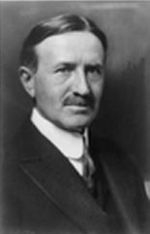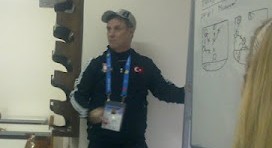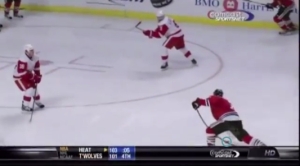- This Drill involves 11 players —5 on offense vs. 5 on defense and 1 goalie
- It is executed for 60 seconds
- Change the rules of the drill to match your needs
Drill #1: 2-1-2 Zone Coverage:
Rules: No stick handling, no shooting, no board passes and no cycling. We are emphasize passing, moving & crossing! The defensive team has stick up side down. Each defensive player executes their defensive zone responsibilities in 2-1-2 zone. One offensive player who has the puck must execute 1X, 1, 2 and 3 Touch passes. If the player with the puck holds on to the puck for more then 3 strides the pass does not count. The other four offensive players must get open for a pass. The offensive team is stressing skating and moving the puck.
The drill is initiated by a coach passing the puck to offensive player. From this pass forward every time a pass is completed the receiver yells the # on the catch. A coach always encourages offensive movement. The coach must keep the focus on live puck & plays. If the puck leaves the defensive zone, the coach passes to open offensive player. On any deflected pass or turnover pass a coach quickly passes the puck to an offensive player to keep the pace of the drill moving.
As a defender, your responsibility is to NOT allow your man to receive a pass . Execute your defensive responsibilities in a 2-1-2 zone and deny passes everywhere. At the end of the allotted time you count the number of catches by the offense as a unit, and the number of catches by individual players. The drill flip flops with the offense going to defense and the defense going to offense. Use four rotations. Great conditioner, very competitive, high accountability.
Drill #2: 2-1-2 Zone Coverage
Rules: Use of Stick handling, Puck Protection, Board Passing, Cycling, Crosses, Invert Offense and Passing. We are emphasize puck control, cycling, crosses and invert offense! The defensive team has stick up side down. Each defensive player executes their defensive zone responsibilities in 2-1-2 zone. The offensive team is stressing puck protection, moving & executing cycles, crosses and invert plays. We are stressing interchangeable positions of the 5 offensive players, but always maintaining good defensive balance.
The drill is initiated by a coach passing the puck to offensive player. From this pass forward; Every time a pass or the the puck is exchanged with pass, cycle, cross or board pass the receiver yells the # on possession /catch. A coach always encourages offensive movement. The coach must keep the focus on live puck & plays. If the puck leaves the defensive zone, the coach passes to open offensive player. On any deflected pass or turnover pass a coach quickly passes the puck to an offensive player to keep the pace of the drill moving.
As a defender, your responsibility is to NOT allow your man to receive a pass . Execute your defensive responsibilities in a 2-1-2 zone and deny passes everywhere. At the end of the allotted time you count the number of catches by the offense as a unit, or the number of catches by individual players. The drill flip flops with the offense going to defense and the defense going to offense. Use four rotations. Great conditioner, very competitive, high accountability.
Variations:
I have 9 variations to this drill. When teaching “Man to Man” Make players play different positions and guard different offensive players.
Power Thoughts:
“Always forgive your enemies; nothing annoys them so much.”
–Oscar Wilde, Irish writer and poet.
Related Videos & Teaching Points:
Keith McAdams Coaching Tips: SWEDEN IMPOSE THEIR STYLE …














